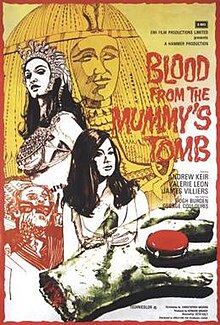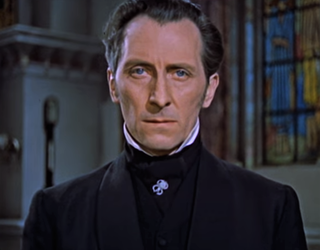
Peter Wilton Cushing was an English actor. His acting career spanned over six decades and included appearances in more than 100 films, as well as many television, stage and radio roles. He achieved recognition for his leading performances in the Hammer Productions horror films from the 1950s to 1970s, and as Grand Moff Tarkin in Star Wars (1977).
Hammer Film Productions Ltd. is a British film production company based in London. Founded in 1934, the company is best known for a series of Gothic horror and fantasy films made from the mid-1950s until the 1970s. Many of these involve classic horror characters such as Baron Victor Frankenstein, Count Dracula, and the Mummy, which Hammer reintroduced to audiences by filming them in vivid colour for the first time. Hammer also produced science fiction, thrillers, film noir and comedies, as well as, in later years, television series.
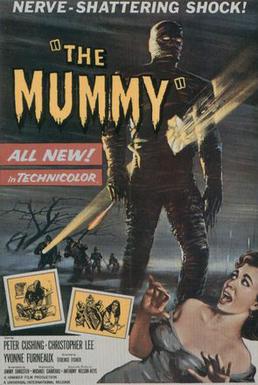
The Mummy is a 1959 British horror film, directed by Terence Fisher and starring Peter Cushing and Christopher Lee. It was written by Jimmy Sangster and produced by Michael Carreras and Anthony Nelson Keys for Hammer Film Productions. The film was distributed in the U.S. in 1959 on a double bill with either the Vincent Price film The Bat or the Universal film Curse of the Undead.

Andrew Keir was a Scottish actor who appeared in a number of films made by Hammer Film Productions in the 1960s. He was also active in television, and especially in the theatre, in a professional career that lasted from the 1940s to the 1990s.

The Jewel of Seven Stars is a horror novel by Irish writer Bram Stoker, first published by Heinemann in 1903. The story is a first-person narrative of a young man pulled into an archaeologist's plot to revive Queen Tera, an ancient Egyptian mummy. It explores common fin de siècle themes such as imperialism, the rise of the New Woman and feminism, and societal progress.

Terence Fisher was a British film director best known for his work for Hammer Films.
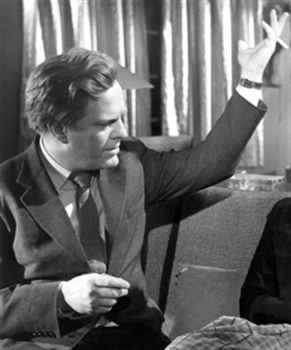
Seth Holt was a Palestinian-born British film director, producer and editor. His films are characterized by their tense atmosphere and suspense, as well as their striking visual style. In the 1960s, Movie magazine championed Holt as one of the finest talents working in the British film industry, although his output was notably sparse.

The Gorgon is a 1964 British horror film directed by Terence Fisher for Hammer Films. It stars Christopher Lee, Peter Cushing, Richard Pasco and Barbara Shelley.

The Curse of the Werewolf is a 1961 British horror film directed by Terence Fisher and starring Clifford Evans, Oliver Reed and Yvonne Romain. It was based on the novel The Werewolf of Paris by Guy Endore. If was produced by Anthony Hinds for Hammer Film Productions.

Bray Film Studios is a British film and television facility in Water Oakley near Bray, Berkshire. It is best known for its association with Hammer Film Productions.
Valerie Therese Leon is an English actress and model who has had roles in many film and television productions, including six of the Carry On film series and two James Bond films, The Spy Who Loved Me (1977) and Never Say Never Again (1983) alongside Roger Moore and Sean Connery, respectively. She also had roles in high-profile films such as The Italian Job (1969), The Wild Geese (1978) and Revenge of the Pink Panther (1978) and had a starring role in the Hammer horror film Blood from the Mummy's Tomb (1971).

The Curse of the Mummy's Tomb is a 1964 British horror film produced, written and directed by Michael Carreras, starring Terence Morgan, Ronald Howard, Fred Clark and introducing Jeanne Roland.

Maniac is a 1963 British psychological thriller film directed by Michael Carreras and starring Kerwin Mathews, Nadia Gray and Donald Houston.

Lust for a Vampire, also known as Love for a Vampire or To Love a Vampire, is a 1971 British Hammer Horror film directed by Jimmy Sangster, starring Ralph Bates, Barbara Jefford, Suzanna Leigh, Michael Johnson, and Yutte Stensgaard. It was given an R rating in the United States for some violence, gore, strong adult content and nudity. It is the second film in the Karnstein Trilogy, loosely based on the 1872 Sheridan Le Fanu novella Carmilla. It was preceded by The Vampire Lovers (1970) and followed by Twins of Evil (1971). The three films do not form a chronological development, but use the Karnstein family as the source of the vampiric threat and were somewhat daring for the time in explicitly depicting lesbian themes.
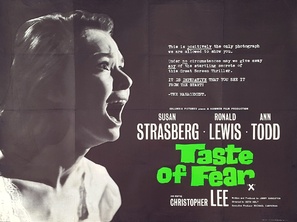
Taste of Fear is a 1961 British thriller film directed by Seth Holt. The film stars Susan Strasberg, Ronald Lewis, Ann Todd, and Christopher Lee in a supporting role. It was released in the United States as Scream of Fear.
Michael Henry Carreras was a British film producer and director. He was known for his association with Hammer Films, being the son of founder James Carreras, and taking an executive role in the company during its most successful years.

The Awakening is a 1980 British horror film directed by Mike Newell in his directorial debut and starring Charlton Heston, Susannah York, and Stephanie Zimbalist. It is the third film version of Bram Stoker's 1903 novel The Jewel of Seven Stars, following the 1970 television adaptation as The Curse of the Mummy for the TV series Mystery and Imagination, and the 1971 theatrical film by Hammer, Blood from the Mummy's Tomb. It was released by Warner Bros.

Bram Stoker's Legend of the Mummy, or simply Bram Stoker's The Mummy, is a 1998 American fantasy horror film based on Bram Stoker's 1903 novel The Jewel of Seven Stars. Directed by Jeffrey Obrow, who is one of the writers that adapted the novel for the film, it features an ensemble cast that includes Louis Gossett Jr., Eric Lutes, Amy Locane, Lloyd Bochner, Victoria Tennant, Mary Jo Catlett, Aubrey Morris, and Richard Karn. Morris previously appeared in Blood from the Mummy's Tomb, a 1971 Hammer Films adaptation of the same novel.

Vampirella is a 1996 American direct-to-video superhero film which was part of the Roger Corman Presents series. It was based on the Vampirella comic book.
The World of Hammer is a British television documentary series created and written by Robert Sidaway and Ashley Sidaway, and produced by Robert Sidaway.
